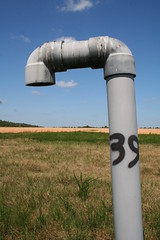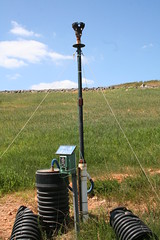I write plenty about keeping food out of landfills to prevent greenhouse gas emissions. So it was high time I visited a landfill specifically to see what a few methane handling systems look like.
Friday, I went to Orange (County, N.C.) Regional Landfill where my trash used to go, before I moved to the next town. My current home, Durham, N.C., trucks its waste one state north–and you thought Virginia was for lovers?!
 Anyway, it was a twofer. The older part of the landfill, which is now closed, has “passive vents,” as pictured to the right. Essentially, that means engineers have dug holes and inserted pipes to facilitate the harmful methane’s escape into the atmosphere. Not exactly a progressive idea. It prevents landfill fires from gas buildup, but does nothing to address the environmental issues.
Anyway, it was a twofer. The older part of the landfill, which is now closed, has “passive vents,” as pictured to the right. Essentially, that means engineers have dug holes and inserted pipes to facilitate the harmful methane’s escape into the atmosphere. Not exactly a progressive idea. It prevents landfill fires from gas buildup, but does nothing to address the environmental issues.
The active section of the landfill is “flaring” its methane. That means a collection system captures the methane and sends it to a series of flares, where the methane is burned into carbon dioxide.
 While that sounds terrible, it’s actually an improvement because methane is so much more harmful (21x) than carbon dioxide. Plus, it doesn’t produce new carbon because it already existed (in the food). Still, it’s not all that progressive, because it lets a potential energy source escape and the collection systems miss a sizable amount of methane.
While that sounds terrible, it’s actually an improvement because methane is so much more harmful (21x) than carbon dioxide. Plus, it doesn’t produce new carbon because it already existed (in the food). Still, it’s not all that progressive, because it lets a potential energy source escape and the collection systems miss a sizable amount of methane.
The real answer (in addition to sending less food waste to the landfill!) is to harness that methane to create energy–either electricity or liquified natural gas. That could be in Orange County’s future and it should be based on the trend of increasing food waste. Fingers crossed.